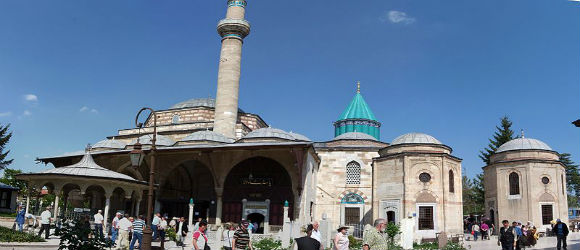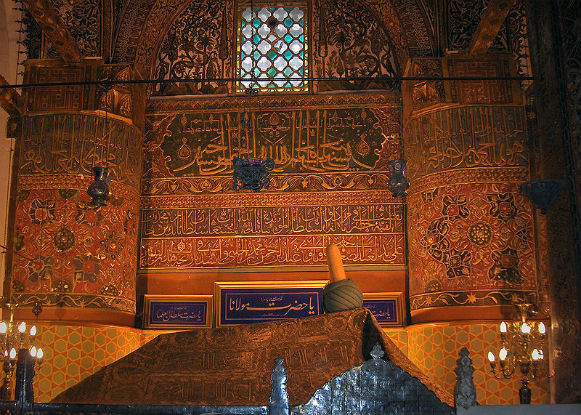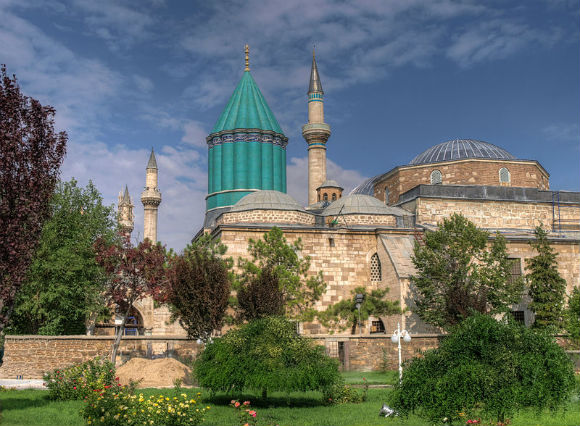The Mevlana Museum also known as the Green Mausoleum or Green Dome, is the original lodge of the Mevlevi Whirling Dervishes, a mystical Sufi Muslim group. It containes the tomb and shrine of the Mevlana, or Rumi, which remains an important place of pilgrimage.
History
Sultan ‘Ala’ al-Din Kayqubad, the Seljuk sultan who had invited Mevlana to Konya, offered his rose garden as a fitting place to bury Baha’ ud-Din Walad (or Bahaeddin Veled), the father of Mevlana, when he died in 1231. When Mevlana himself died on December 17, 1273, he was buried next to his father.
Mevlana’s successor Hüsamettin Çelebi built a mausoleum (Kubbe-i-Hadra) over the grave of his master. The Seljuk construction, under architect Behrettin Tebrizli, was finished in 1274. Gürcü Hatun, the wife of the Seljuk Emir Suleyman Pervane, and Emir Alameddin Kayser funded the construction.
The cylindrical drum of the of the dome originally rested on four pillars. The conical dome is covered with turquoise faience. Several sections were added until 1854. Selim I decorated the interior and performed the woodcarving of the catafalques.
A decree by Ataturk in September 1925 dissolved all Sufi brotherhoods in Turkey. On April 6, 1926, another decree ordered that the Mevlana mausoleum and dervish lodge be turned into a museum. The museum opened on March 2, 1927.
Special permission granted by the Turkish government in 1954 allowed the Mawlawi dervishes of Konya to perform their ritual dances for tourists for two weeks each year. Despite government opposition the order has continued to exist in Turkey as a religious body. The tomb of Rumi, although officially part of a museum, attracts a steady stream of pilgrims.
What to See
The dervish lodge (tekke) includes a semahane, where the ritual sema or whirling ceremony takes place, a sadirvan for ritual ablutions, a library, living and teaching quarters, and the mausoleum housing the tomb of Celaleddin Rumi, founder of the sect and later awarded the honorable title of Mevlana. His epitaph reads: “Do not seek our tombs on this earth – our tombs are in the hearts of the enlightened.”
The mausoleum room is highly ornamented with Islamic script and enameled reliefs, and contains the tombs of several of the more important figures of the dervish order. The main tomb enclosed behind a silver gate crafted in 1597 is that of Mevlana. The tomb of his father, Bahaeddin Veled, is upright and adjacent to his son’s, a position that signifies respect.
The adjoining room, or the semihane, is now a museum of Mevlana memorabilia displaying musical instruments and robes belonging to Mevlana, along with Selçuk and Ottoman objects like gold-engraved Korans from the 13th century. Among the fabulous ancient prayer rugs is the most valuable silk carpet in the world.
Mevlana Museum, Konya,




Most cities of Turkey show a secular face for tourists, but Konya (centred on Mevlana) is unashamedly a religious centre and a place of pilgrimage. As such it is an opportunity to see and experience a vital part of Turkish life and consciousness.
The interior of the iconic mosque is beautifully decorated – the mausoleum area is awe inspiring and…
The tomb of Rumi is indeed moving and the story of the dervishes fascinating. The renovated dervish quarters are well done, although it does help to have a guide who can explain more about the Sufi mystics.
It's not just the graves of Mevlana Rumi (& his family), but it's experiencing Sufism very closely… Learn how one would become a Sufi, the techniques used during the time, & before this institution was abolished after Kamal Ataturk… Luckily, we got a chance to photograph the graves as there was this other guy from the ministry who was photographing,…
Traveled to Konya and visit this beautiful and relaxing place, the lack of information you can use the audio guide and enjoy.
The best time to visit this place is from December 14 to December 17, the night of Rumi's death the night of December 17 is known as the most beautiful wedding night sky dance, takes place on this…
Good place to spend an hour with someone who can explain the history.
This is a fascinating museum which depicts the training and life of whirling dervishes. The museum is joused around the mausoleum of Mevlana, who was instrumental in starting the Mevlevi Order. Apart from the interesting exhibits, the buildings and grounds themselves are very attractive. This is definitely worth a visit if you are anywhere near Konya
Don't get me wrong: the Mevlana Museum is a different side of Islam than you see elsewhere, a place celebrating poetry, peace, and quiet rumination. Unfortunately, you won't experience much of that spirit yourself. The museum is a major pilgrimage site for Muslims, and the crowds are beyond belief. Within the main building, where the tomb and religious relics are…
Rumi is not referred to by that name here. I suggest yu read a bit of his bio before you come. There is an excellent tape tour for 5 TL. Entry to the grounds and museum is only 3 TL
The grounds are mainly a beautiful rose garden with many seating areas. Pictures are not allowed inside the actual museum…
My husband & I visited here during our October 2012 ‘Grand Tour of Turkey’, with Cosmos. We very much liked the place but wished (selfishly) that we could be on our own as it demands introspection & contemplation; not really possible with all the crowds.
I knew a little about Rumi beforehand, having admired his quotes & talked to friends…
These two shrines are part of the pilgrimage that Sufi Muslims make every day of every year, but most especially on Dec 17th, the anniversary of Rumi's death. My visit to both shrines were truly spiritual in nature, with one leaving feeling different than upon your entry. I highly recommend visiting BOTH, first Shams i Tabriz's shrine, and then Rumi's.